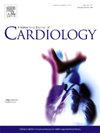外周动脉疾病患者心肌梗死的危险因素
IF 3.2
2区 医学
Q2 CARDIAC & CARDIOVASCULAR SYSTEMS
引用次数: 0
摘要
背景:外周动脉疾病(PAD)是一种世界性的主要健康问题,其特征是由于阻塞性动脉粥样硬化导致下肢动脉血流量减少。PAD不仅有四肢不良事件的高风险,还有心血管事件,如心肌梗死(MI)。方法:采用德国全国住院患者统计数据。纳入了2005-2020年德国因PAD入院的所有患者病例,并对mi的发生进行了分层。结果:总体而言,我们的研究2005-2020年纳入了2,825,765例因PAD入院的患者病例。其中,24,072例PAD患者(0.9% %)患有心肌梗死。合并心肌梗死的PAD患者年龄较大(≥70 岁的患者比例:69.6 % vs. 54.2% %,P )。结论:心肌梗死发生率为0.9% %的PAD患者,其病死率增加10倍以上。因PAD入院患者心肌梗死事件的独立危险因素包括年龄 ≥ 70 岁、糖尿病、高脂血症、肺部疾病和癌症。本文章由计算机程序翻译,如有差异,请以英文原文为准。

Risk factors for myocardial infarction in patients with peripheral artery disease
Background
Peripheral artery disease (PAD) is a worldwide major health problem characterized by a reduced blood flow in the arteries of the lower limbs due to obstructive atherosclerosis. PAD is afflicted by a high risk for adverse events of the limbs, but also by cardiovascular events such as myocardial infarction (MI).
Methods
The German nationwide inpatient statistics was used for this study. All patient-cases of patients admitted due PAD in Germany 2005–2020 were included and stratified for occurrence of MI.
Results
Overall, 2,825,765 patient-cases of patients admitted due to PAD were included in our study 2005–2020. Among these, 24,072 PAD patients (0.9 %) were afflicted by MI. PAD patients with MI were older (proportion of patients aged ≥70 years: 69.6 % vs. 54.2 %, P < 0.001) and revealed an aggravated comorbidity profile. In-hospital case-fatality rate was more than 10-fold increased driven by MI (29.0 % vs. 2.7 %, P < 0.001).
Age ≥ 70 years (OR 1.193 [95 %CI 1.158–1.229], P < 0.001), diabetes mellitus (OR 1.405 [95 %CI 1.369–1.442], P < 0.001), hyperlipidaemia (OR 1.099 [95 %CI 1.069–1.129], P < 0.001), COPD (OR 1.105 [95 %CI 1.064–1.148], P < 0.001), kidney disease (OR 1.857 [95 %CI 1.806–1.910], P < 0.001), heart failure (OR 4.907 [95 %CI 4.769–5.048], P < 0.001), atrial fibrillation/flutter (OR 1.177 [95 %CI 1.142–1.213], P < 0.001), cancer (OR 1.343 [95 %CI 1.242–1.451], P < 0.001) and pneumonia (OR 5.214 [95 %CI 5.021–5.414], P < 0.001) were independently associated with MI.
Conclusions
MI occurred in 0.9 % of the PAD patients and was afflicted by more than 10-fold increased case-fatality. Independent risk factors for MI events in patients admitted due to PAD comprised age ≥ 70 years, diabetes mellitus, hyperlipidaemia, lung diseases, and cancer.
求助全文
通过发布文献求助,成功后即可免费获取论文全文。
去求助
来源期刊

International journal of cardiology
医学-心血管系统
CiteScore
6.80
自引率
5.70%
发文量
758
审稿时长
44 days
期刊介绍:
The International Journal of Cardiology is devoted to cardiology in the broadest sense. Both basic research and clinical papers can be submitted. The journal serves the interest of both practicing clinicians and researchers.
In addition to original papers, we are launching a range of new manuscript types, including Consensus and Position Papers, Systematic Reviews, Meta-analyses, and Short communications. Case reports are no longer acceptable. Controversial techniques, issues on health policy and social medicine are discussed and serve as useful tools for encouraging debate.
 求助内容:
求助内容: 应助结果提醒方式:
应助结果提醒方式:


